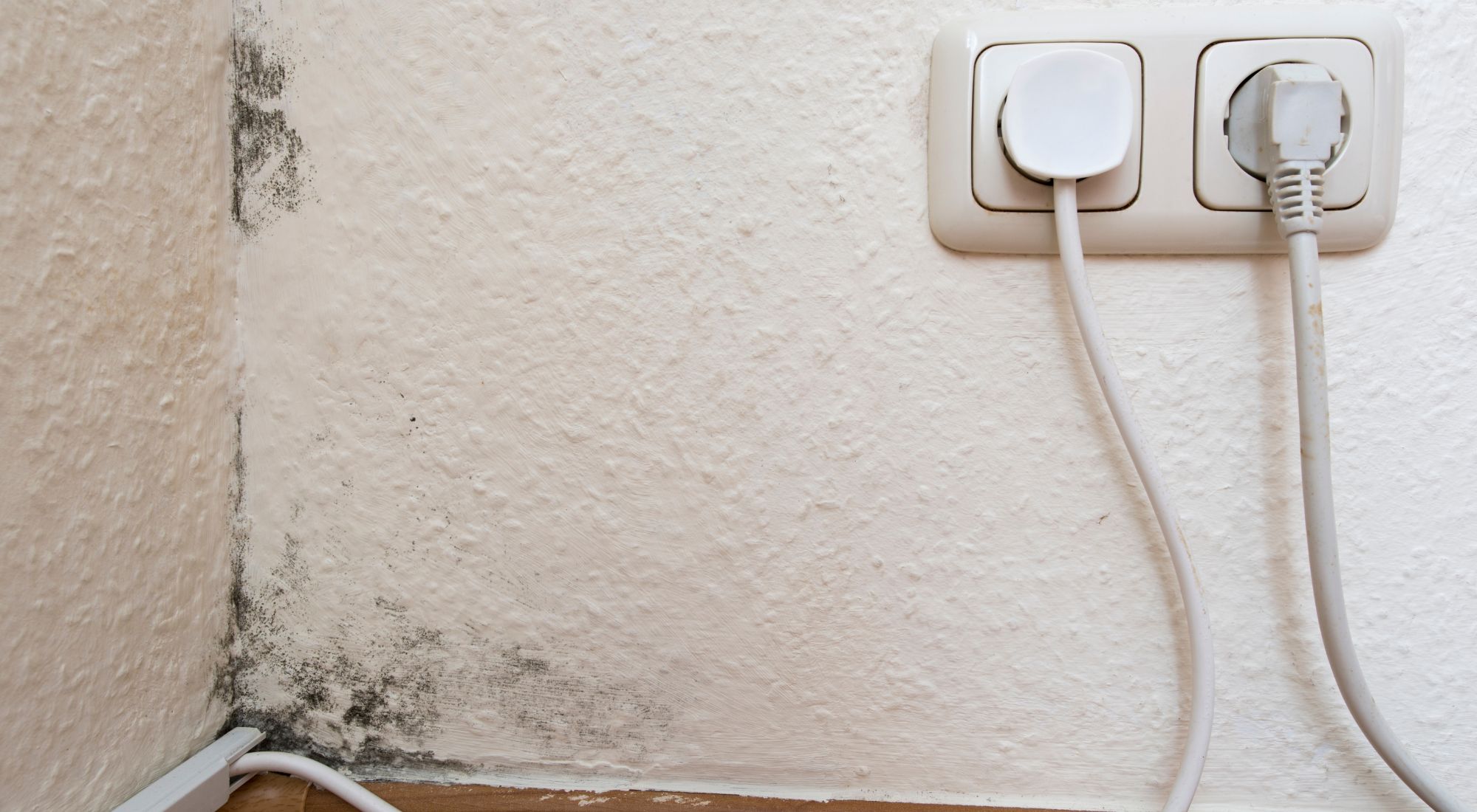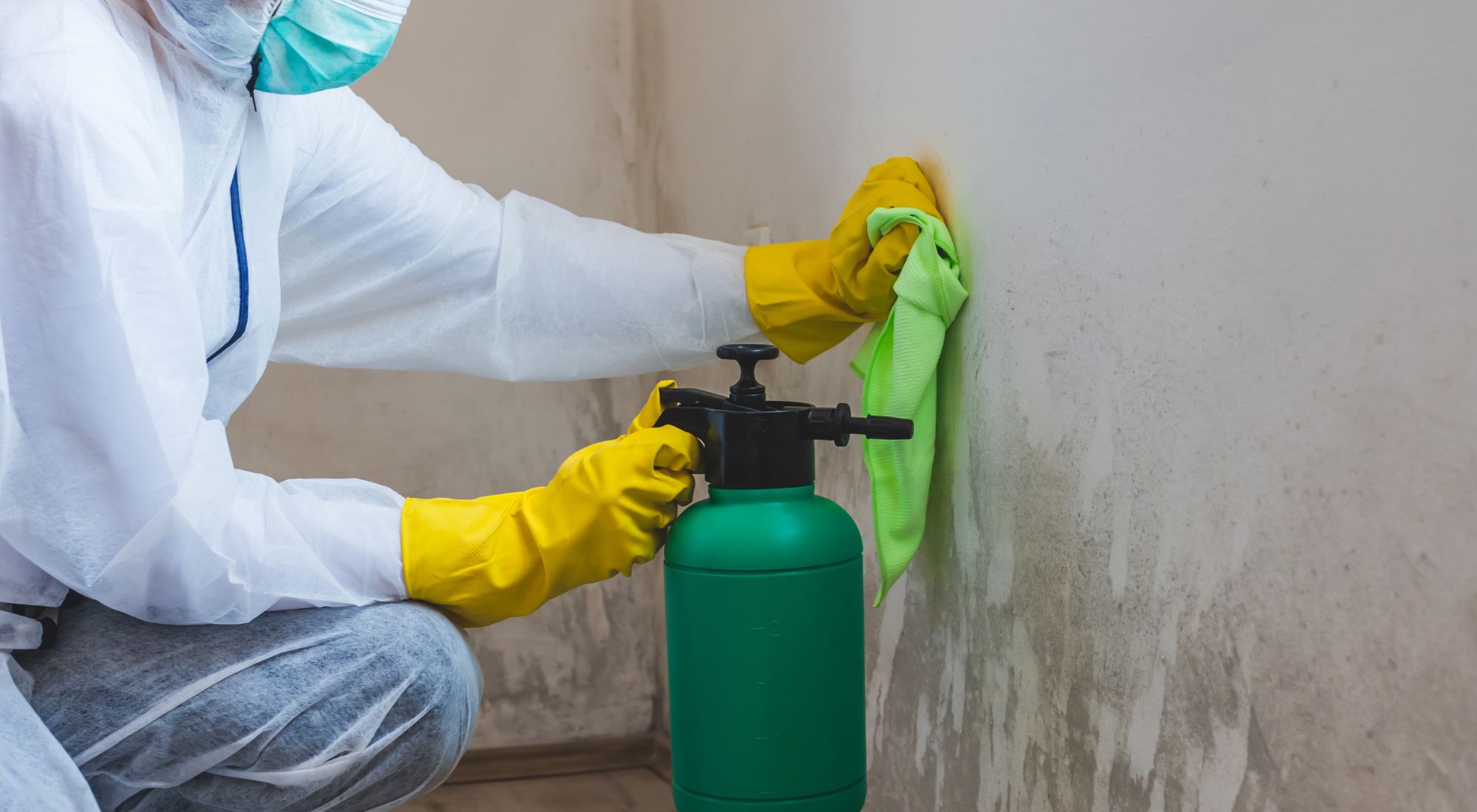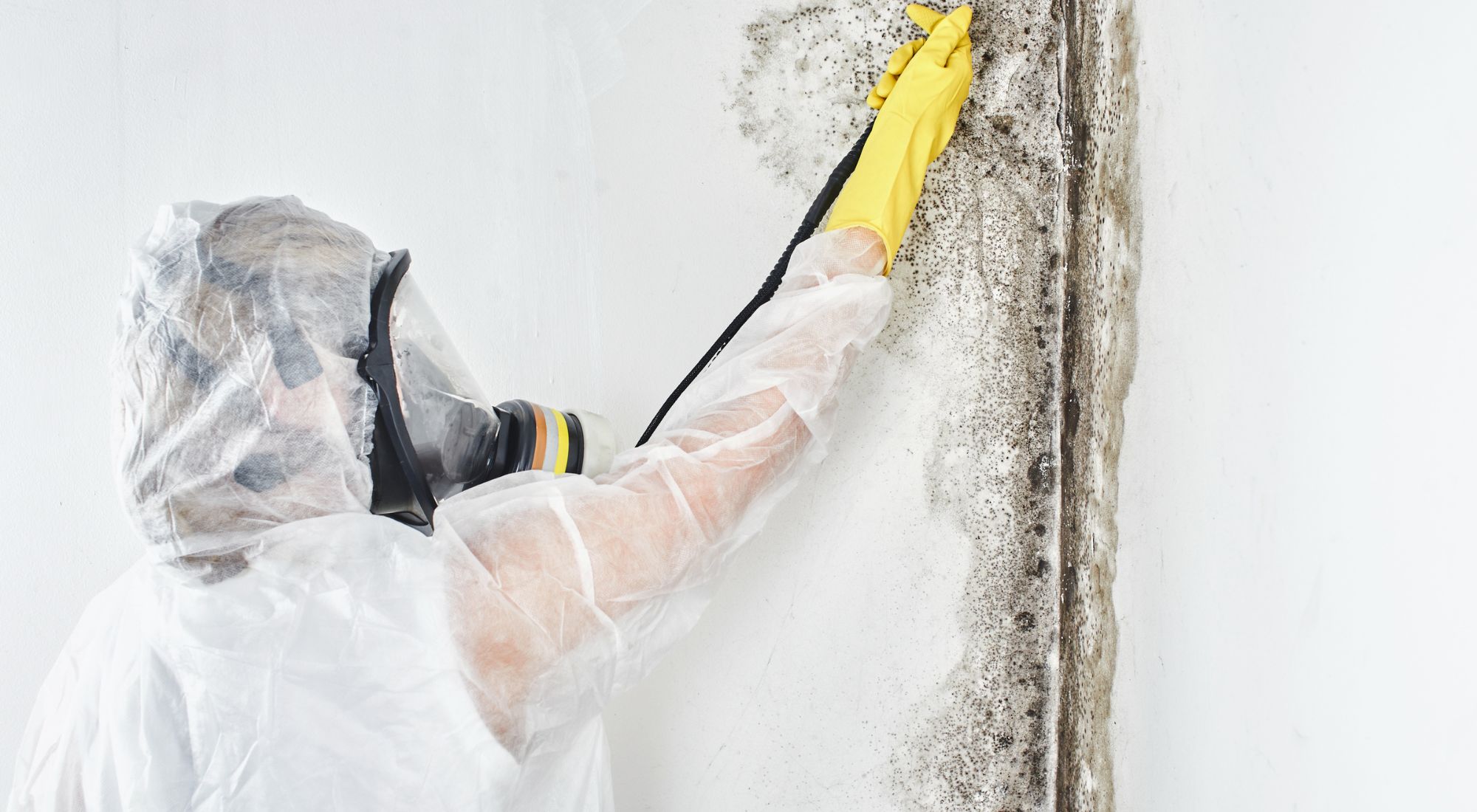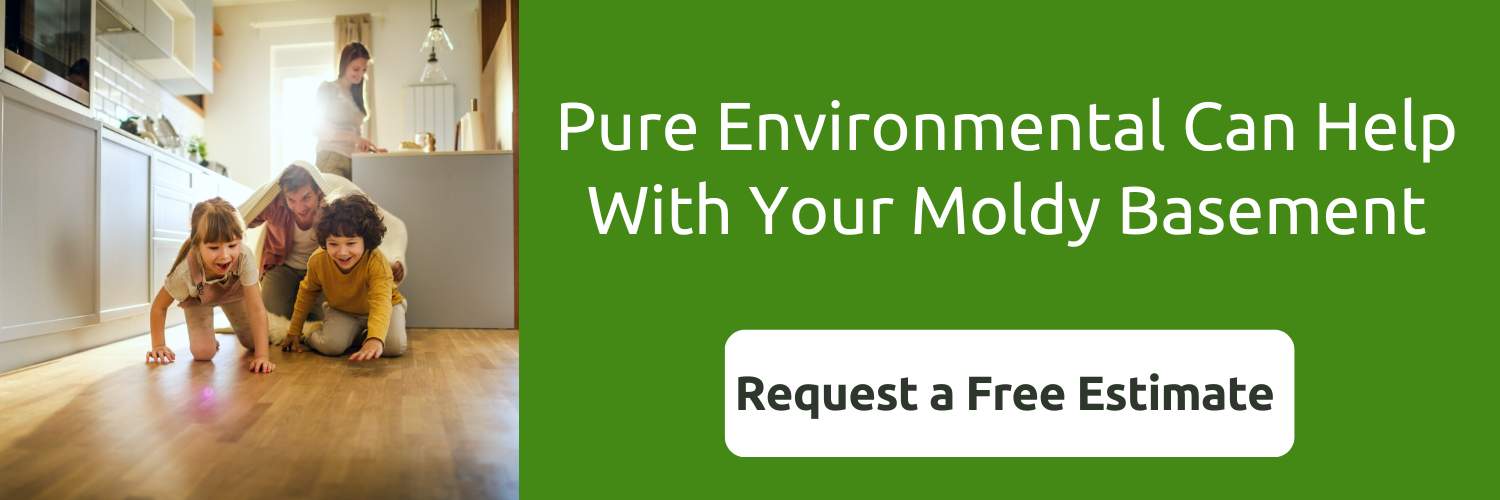Very few terms spark horror stories from renters and homeowners alike as the words “black mold”.
But what do we really know about black mold besides it’s “toxic?”
Not all black mold is created equal, yet with such a dangerous classification, the term seems to be tossed around with little clarification.
We’re here to clear up any foggy ideas, like the differences between black mold and other molds that are black, answer frequently asked questions, and more.
Table of Contents
- Toxic Black Mold vs. Black-Colored Mold
- What Does Black Mold Look Like?
- The Health Hazards of Black Mold Exposure
- How Do You Get Rid of Black Mold?
- Pure Environmental Can Help You Safely Remove Toxic and Non-toxic Black Mold

Toxic Black Mold vs. Black-Colored Mold
The term black mold has become a buzzword villainizing mold of all types, but not all mold is toxic.
Unless you have a mold allergy, most species of mold are unlikely to pose a serious risk to humans or other living organisms. Certain molds are even used to make foods and medicines, like blue cheese and penicillin.
Of the many species of mold, some types of mold can be black and non-toxic.
Black-colored molds like Nigrospora sphaerica and Cladosporium are the most common molds found indoors and outdoors but are not considered toxic.
A host of other non-toxic molds include:
These molds can appear black but don’t produce mycotoxins, the naturally occurring toxins produced by certain fungi that can make the mold dangerous.
When it comes to the toxic black mold commonly found in homes, the species of microfungus is called Stachybotrys chartarum (S. chartarum). This type of black mold feeds on materials like paper, wood, and drywall.
S. chartarum also requires more moisture than other molds to thrive, making leaky pipes, bathrooms, and leaks inside walls the perfect breeding ground for the toxic spores.
Yet not all strains of S. chartarum produce mycotoxins and under certain conditions, some lose the ability to produce mycotoxins over time.
Still, with a possible health risk at hand, it’s important to treat all black-colored mold with caution until you know what type of mold you have.
How Do You Know If You Have Toxic Black Mold or Black-Colored Mold?
It can be hard to tell if you have toxic black mold or black-colored mold with the naked eye, so you should test it to be sure. You can find at-home mold tests at your local hardware store, but beware — the accuracy of at-home tests can’t be guaranteed.
The safest way to ensure you know exactly what type of mold you are dealing with and whether or not you can take treating matters into your own hands is by having it professionally tested.
Whether you have toxic black mold or black-colored mold, if there’s more than ten square feet of it, the Environmental Protection Agency (EPA) advises enlisting the help of a mold remediation specialist.
The mold removal experts at Pure Environmental will conduct an initial inspection to determine if testing is necessary. To test, we will typically utilize a third party to
safely collect a sample of the mold and send it to a laboratory partner who will accurately detect the types of mold growing in your home.
What Does Black Mold Look Like?
There’s very little visual difference between toxic black mold and black-colored mold.
S. chartarum can sometimes look greenish-black or grayish-black and can grow in a speckled pattern spreading over a surface resembling black polka dots.
If the mold build-up is concentrated in one area it can also seem to sit close together in a large blob.
Some say that toxic black mold tends to look more slimy or furry than other black-colored mold.
What Does Black Mold Smell Like?
Due to its tendency to grow on damp, decaying surfaces, many claim that toxic black mold has a distinctive musty odor. It’s often compared to the smell of rotting wood or paper, or the stale smell of sweaty socks.
Non-toxic black-colored mold typically doesn’t possess the same recognizable musty, dirty smell of toxic black mold.
Remember, not everyone has the same sensitivity to smell so you may not notice whether something smells “off” in your home right away.
What Causes Black Mold?
A very high humidity indoors is needed to cause toxic black mold to grow compared to other black-colored molds.
A study of indoor infestation of S. chartarum found a relative 97% humidity is required for toxic black mold to grow versus 41% for other molds. In real-world applications, the technicians at Pure Environmental have found mold growing on materials containing 20% or slightly less moisture.
Leaky pipes can create ideal conditions for toxic black mold where wood, wallpaper, and drywall are constantly wet, feeding the mold.
Where Is Black Mold Found?
S. chartarum requires moisture to grow and feeds on matter with high cellulose content. In nature, you’ll find it on wet, decaying organic matter.
In your home, it likes to grow in damp or water-damaged areas on cellulose-rich materials, like drywall and wallpaper.

The Health Hazards of Black Mold Exposure
There are stark differences in the health effects of toxic black mold versus some black pathogenic molds. However, the symptoms can vary and overlap with other conditions.
If you suspect you may be experiencing any symptoms of mold exposure, be it from toxic black mold or black-colored mold, it’s important to see a health practitioner.
Toxic Black Mold Exposure
Long-term indoor exposure to the mycotoxins that S. chartarum can produce can cause serious health effects and has even been linked to immunosuppression and certain types of cancer.
Other potential long-term health issues caused by exposure to toxic black mold can include:
- Chronic Obstructive Pulmonary Disease (COPD)
- Multiple sclerosis (MS)
- Parkinson’s disease; and
- Alzheimer’s disease
S. chartarum can also cause sick-building syndrome and a life-threatening pulmonary hemorrhage in infants.
Symptoms of Toxic Mold Exposure
The most common tell-tale toxic black mold exposure symptoms typically involve the upper respiratory tract.
If you suspect you may be exposed to toxic black mold, you might be experiencing symptoms like:
- Nasal irritation
- Burning and congestion
- Coughing
- Wheezing
- Chest tightness; and
- Dyspnea
Additionally, exposure to toxic mold can create neurological symptoms like:
- Headaches
- Migraines
- Cognitive impairment
- Memory loss; and
- Delirium
Black-Colored Mold Exposure
Exposure to black-colored mold is more likely to cause infection and the development of allergic and asthma effects, like difficulty breathing and Rhinitis.
Though not all molds cause allergy symptoms, some commonly found molds can trigger asthma, allergic responses, or cause infection:
- Alternaria is usually found in the upper respiratory tract including your nose and mouth.
- Aspergillus grows on house dust in warm, extremely damp climates.
- Cladosporium is a common outdoor fungus that can grow on textiles, wood, and other damp, porous materials.
- Penicillium is commonly found on wallpaper, decaying fabrics, carpet, and fiberglass duct insulation and is most known for its medicinal mycotoxin, penicillin.
Long-term exposure to black-colored mold can also have serious long-term effects, especially for babies and young children. One study found that infants who live in moldy homes were three times more likely to develop asthma by age seven.
Symptoms of Black-Colored Mold Exposure
Symptoms of black-colored mold can vary from person to person.
Breathing in mold spores can cause your immune system to respond with symptoms that usually affect the respiratory system and lungs, including:
- Sinusitis
- Sneezing
- Congestion
- Runny nose
- Cough
- Postnasal drip; and
- Itchy and watery eyes
Mold exposure has also been linked to a wide variety of respiratory issues.
Both adults and children who are exposed to mold in their homes are 40% more likely to experience asthma symptoms and severe asthma attacks.
Who Is Most At-Risk for Black Mold Exposure?
The main health risks related to mold exposure are allergies and irritation, which can typically cause respiratory and immunological issues.
Older adults with pre-existing respiratory problems or weakened immune systems can be at risk of fungal infection.
Additionally, infants and children who are still developing strong respiratory and immune systems may be particularly sensitive to black mold exposure.
Lastly, people with asthma or existing allergies to mold should be especially careful of black mold exposure.
How Do You Treat Black Mold?
The trickiest part of treating black mold is to ensure you remove all the spores. However, once you disturb the mold, spores become airborne and can settle anywhere completely undetected.
The underlying cause of the mold must also be addressed, otherwise, the mold will return under the same conditions.
There are a few methods that can be helpful for maintenance cleaning to keep mold away, but the best way to get rid of black mold for good is to call in professionals like Pure Environmental who can inspect, test, and treat your mold problem –– big or small.
Non-toxic Black Mold
If your black mold has been tested and determined to be non-toxic, you may be considering tackling the issue yourself.
The persistent nature of mold means that you may spend more time fighting the same mold issue over and over again than you would having it expertly remediated once and for all.
But if you’re trying to stay ahead of a potential mold issue, maintenance cleaning may be the answer.
There’s no need to go out and buy special cleaners specially formulated to treat mold. You can fight non-toxic black mold in your home using regular household items you likely already have under the kitchen sink.
Lysol
Believe it or not, Lysol contains mold-fighting ingredients that can help keep surfaces mold-free including:
- Hydrogen peroxide
- Potassium hydroxide
- Ethanol; and
- Isopropyl alcohol
These active ingredients are known to kill most surface microorganisms and bacteria, including mold.
Though Lysol makes an aerosol spray, it doesn’t kill mold spores in the air. The spray is meant as a surface cleaner and cannot remain in the air long enough to kill airborne germs like mold.
Baking Soda
Baking soda can be a great cleaning agent for routine home maintenance because it upsets the pH balance of the mold colony.
Mold colonies need a pH balance ranging from 2 (acidic) to 9 (7 being neutral pH) to survive, so any cleaner that has a more alkaline or acidic pH than the mold can upset the balance and stop a mold colony from growing.
To use baking soda for mold maintenance cleaning, dissolve the baking soda in water in a spray bottle. Then spray the affected areas and scrub until the mold is removed. Finally, wipe the area dry with a clean dry towel.
Hydrogen Peroxide
Hydrogen peroxide is an active mold-killing ingredient in Lysol so if you have a bottle of 3% hydrogen peroxide in your cabinet, you can also use it to kill mold spores on surfaces.
Here’s how:
- Pour the hydrogen peroxide into a spray bottle, but do not dilute it.
- Spray the hydrogen peroxide onto the affected area and let it sit on the surface for 10 minutes.
- Scrub the area until the mold is gone and wipe the surface dry with a clean towel.
- Let it air dry, do not rinse the surface.
Borax
Borax, or sodium borate, is a salt derived from boron and is usually mined from dried lake beds.
Borax —not to be confused with its much more dangerous cousin, boric acid — has a high pH of 9.3 and is significantly alkaline.
As we mentioned earlier, anything more alkaline or acidic than mold can be used as a mold-cleaning agent.
To use borax to keep mold away:
- Mix one cup of borax per one gallon of water.
- Apply the solution and scrub using a brush.
- When the surface is clean, wipe it dry and let the surface air dry.
- Do not rinse off the borax.
Toxic Black Mold
If you’ve tested and confirmed, or even suspect you might have toxic black mold in your home, you’ll want to be sure it is properly treated and removed by a trusted professional.
Toxic black mold can be dangerous to anyone in its presence.
Professionals have all the necessary tools in their arsenal to safely access and remove toxic black mold, especially if it’s a potential infestation.
The mold removal experts at Pure Environmental are no strangers to the common mold problems in the Pacific Northwest. Everything from attics to basements to crawl spaces — you name it, we’ve fixed it.

Pure Environmental Can Help You Safely Remove Toxic and Non-toxic Black Mold
Whether you’ve got black-colored mold or toxic black mold, safe and successful mold removal can be a tough and sometimes dangerous job.
But simply killing the mold on the surface won’t get rid of it. Let the experienced team at Pure Environmental eradicate any mold in your home — and keep it away for good.
Our thorough and complete mold abatement process includes our patented PurAyr™ technology, a powerful air and surface decontamination tool designed to safely neutralize any remaining mold spores in the air and on surfaces.
The PurAyr™ rapid oxidation process improves indoor air quality and eliminates odors, finally ridding your home of that musty, moldy smell.
Don’t lose the battle over your home to mold. Contact Pure Environmental today for your free estimate.
Recent posts
- Advice From the Pros: How To Hire a Contractor for Home Renovations
- After the Fire: What To Expect From Smoke Damage Restoration Services
- Home Insurance During Renovations: What Is Covered and What To Know Before Getting Started
- Mitigation and Restoration: Understanding the Difference Between the Two and Why They’re Both Necessary
- Should You Stay or Should You Go? Know When To Walk Away From a House With Mold
